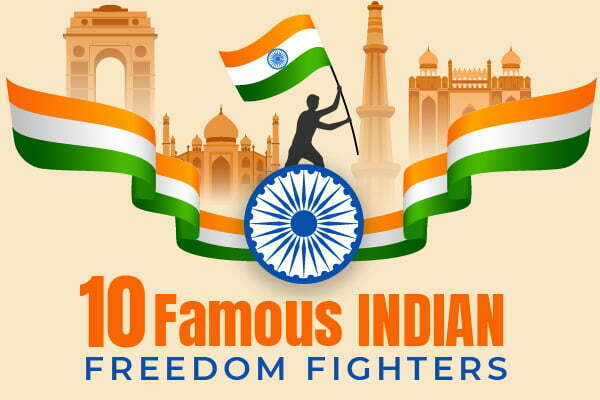Table of Contents
Top 10 Greatest Indian Freedom Fighters
Along with playing a critical role in the country’s independence, freedom fighters have left behind a legacy of bravery, resolve, and unwavering patriotism. Despite not being with us anymore, they continue to inspire millions to fight and preserve our freedom.
Fighting for one’s own country gives a certain sense of national pride. It is this sense of pride and ownership that plays a critical role in keeping our country free and independent. This is why men and women from all parts of the world enlist in the army, navy, or air force to contribute to the safety of their nation. You can be one of those brave soldiers! Read on to learn about the Greatest Indian Freedom Fighters along with their contributions to the nation.
Also read: Famous personalities of India | Top 10 people you must know
Greatest Freedom Fighter of India | Major Contribution |
Mahatma Gandhi | Led non-violent movements like the Salt March and the Quit India Movement |
Jawaharlal Nehru | The first Prime Minister shaped India’s political landscape |
Sardar Vallabhbhai Patel | Unified princely states; led the Bardoli Satyagraha |
Subhas Chandra Bose | Formed the Indian National Army (INA) |
Bhagat Singh | Revolutionary actions like the Assembly bombing, martyrdom-inspired resistance |
Rani Lakshmi Bai | Key leader in the Revolt of 1857 |
Bal Gangadhar Tilak | Advocated Swaraj; emphasized education and nationalism |
Lala Lajpat Rai | Protested colonial policies; was injured during the Simon Commission protest |
Chandra Shekhar Azad | Revolutionary activities like the Kakori Train Robbery |
Mangal Pandey | Sparked the First War of Independence (1857) |
Mahatma Gandhi
Mohandas Karamchand Gandhi is known as the ‘Father of the Nation’ and ‘Mahatma Gandhi’, because of his remarkable efforts. Born on the 2nd of October, 1869, he married Kasturba when he was 13, studied law in London, and then traveled to South Africa for practice. South Africa is where he was inspired to fight for human rights after witnessing racial injustice against some Indians. After witnessing India’s condition under British rule, Gandhi became a fervent supporter of the independence movement. He protested against the salt taxes and led various nonviolent anti-British campaigns in his quest for independence. The non-cooperation movement and the Quit India movement were some of the most significant movements taken up by Mahatma Gandhi.
Jawaharlal Nehru
Jawaharlal Nehru, born in 1889, was the only son of Motilal Nehru and Swarup Rani. Nehru began his career as an attorney before becoming well-known as an Indian independence fighter and politician. Mahatma Gandhi’s attempts to free India from the British influenced his determination for India’s independence.
He became involved in the liberation struggle, rising to the position of President of the Indian National Congress before becoming India’s first Prime Minister after independence. His nickname was Nehru Chacha because he loved children so much that his birthday is declared as Children’s Day.
Sardar Vallabhai Patel
Sardar Vallabhbhai Patel, born in 1875, gained the title of ‘Sardar’ due to his heroic efforts in the Bardoli Satyagrah. He has been a fearless individual from an early age. The title “Iron Man of India” was declared because of his willpower and determination for the country. Sardar Patel began his career as a lawyer, but he left the profession to fight for India’s independence from British domination. Following India’s independence, he became the country’s Deputy Prime Minister and committed himself to uniting the nation, a task he completed successfully.
Discover: Civil Disobedience movement | A movement to achieve freedom
Subhash Chandra Bose
Subhas Chandra Bose was, without a doubt, one of the greatest Indian freedom fighters in history. He was born on January 23rd, 1897. From the early 1920s till the end of 1930, he was the leader of the radical wing of Congress. He established the Indian National Army (INA) with Japanese assistance. Despite his formal cause of death being attributed to an Aircraft accident in 1945, speculations about it being a cover-up or a complete fabrication persist to this day.
Bhagat Singh
Bhagat Singh, born in 1907, was born into a Sikh family in Punjab’s undivided state and held firmly to his values of patriotism till his death.
He was one of India’s most radical revolutionaries. Singh was contentious but a well-respected figure in India’s quest for freedom.
Bhagat, along with Batukeshwar Dutt, bombed the Central Legislative Assembly in Delhi on April 8, 1929. A death penalty for Bhagat and life imprisonment for Dutt thereafter. Singh was only 23 to achieve so much as a front-line warrior fighting for India’s independence. The history is incomplete without the name and sacrifice of Bhagat Singh.
Rani Laxmibai
Rani Laxmibai, the queen of the princely state of Jhansi in North India, became a symbol of women’s resistance throughout India’s independence struggle. Her name was ‘Manikarnika’ when she was born in Kashi in 1828. She married Gangadhar Rao, the King of Jhansi, when she was just 12 years old. Following her husband’s death, Rani Laxmibai assumed control of the state’s government. She made it obvious to the British that she would not submit to their authority. For seven days, she heroically defended her region with a little army. She battled the British valiantly till killed in Gwalior in 1858.
Bal Gangadhar Tilak
Tilak was an outstanding Indian freedom fighter, born in 1856. Bal Gangadhar Tilak initiated the slogan – “Swaraj is my birthright.” He was known as one of the Lal, Bal, and Pal triad. Tilak started schools and published periodicals to resist the British rulers.
Lala Lajpath Rai
Lala Lajpat Rai, also known as Punjab Kesari, was born in Punjab in 1865. Rai was one of the Indian National Congress’s radical members and was a member of the Lal-Bal-Pal trio. He rose to prominence after leading the Non-Cooperation Movement and the Punjab Protest against the Jallianwala Bagh event in 1920. The Britishers, in a Lathi charge, killed him during a Simon Commission demonstration in 1928.
Read more: The first Indian woman in space – Kalpana Chawla
Chandrashekhar Azad
Chandrashekhar Azad was a fierce Indian revolutionary who vowed never to be captured alive by the British. He joined the independence movement at a young age and became a prominent leader of the Hindustan Republican Association. Known for his expert marksmanship and strategic planning, Azad orchestrated several attacks against the British government. True to his word, he died by suicide in Alfred Park, Allahabad, in 1931, when surrounded by British police, choosing death over capture.
Mangal Pandey
Mangal Pandey was a sepoy in the British East India Company’s army who became a catalyst for the Indian Rebellion of 1857. His famous revolt at Barrackpore was triggered by the introduction of greased cartridges that allegedly contained cow and pig fat, offending both Hindu and Muslim soldiers. Pandey’s brave stand against the British, which led to his execution on April 8, 1857, inspired countless Indians and marked the beginning of India’s first war of independence.
Keep reading: Top 10 best humans in the World
Key Takeaways
- India’s freedom has been possible due to the contributions of multiple Great Indian Freedom Fighters who might not be on our list, but that still doesn’t mean that their contributions have been any less.
- Since India’s independence some seven decades ago, the country has evolved at a quicker rate, the roots of which exist in the efforts taken by the Greatest Freedom Fighters of India.
- The country is developing economically and socially, and it is on the road to progress.
- This progress would be incomplete without the foundational steps taken by India’s pioneers of freedom.
If you are interested in taking the first step to contribute to your country’s safekeeping, peace and independence by enrolling into a military school, we are here to help you! In case of any queries, reach out to us or drop a comment below!
Liked this blog? Read next: Babasaheb Ambedkar | Some amazing facts about the life of the great man
FAQs
Ques 1: Who are some other female freedom fighters?
Answer 1: Some of the Indian female freedom fighters are as follows –
- Aruna Asaf Ali
- Kasturba Gandhi
- Madam Bhikaji Cama
- Annie Besant
- Begum Hazrat Mahal
Ques 2: Who is the fire girl of Bengal?
Answer 2: Bina Das (24 August 1911—1986), an Indian revolutionary and nationalist from West Bengal, is the fire girl of Bengal.
Ques 3: Who coined the term ‘Quit India’?
Answer 3: Congress leader Yusuf Meherally coined the term ‘Quit India’.
Ques 4: Who are the freedom fighters of India?
Answer 4: Here are the top 100 freedom fighters of India:
- Veer Savarkar
- Lala Lajpat Rai
- Bal Gangadhar Tilak
- Dr. Rajendra Prasad
- Dr. Lal Bahadur Shastri
- Sardar Vallabhabhai Patel
- Bhagat Singh
- Subhas Chandra Bose
- Mahatma Gandhi
- Jawaharlal Nehru
- Gopal Krishna Gokhale
- Chandra Shekhar Azad
- Dadabhai Naoroji
- Tantia Tope
- Bipin Chandra Pal
- Ashfaqulla Khan
- Nana Sahib
- Sukhdev
- Kunwar Singh
- Mangal Pandey
- V.D Savarkar
- Annie Besant
- Rani Lakshmi Bai
- Begum Hazrat Mahal
- Kasturba Gandhi
- Kamla Nehru
- Vijay Laxmi Pandit
- Sarojini Naidu
- Aruna Asaf Ali
- Madam Bhikaji Cama
- Kamla Chattopadhyay
- Sucheta Kriplani
- Kittur Chennamma
- Savitribai Phule
- Usha Mehta
- Lakshmi Sahgal
- Dr. B.R Ambedkar
- Rani Gaidinliu
- Pingali Venkayya
- Veerapandiya Kattabomman
- Bakht Khan
- Chetram Jatav
- Bahadur Shah Zafar
- Manmath Nath Gupta
- Rajendra Lahiri
- Sachindra Bakshi
- Roshan Singh
- Jogesh Chandra Chatterjee
- Bagha Jatin
- Kartar Singh Sarabha
- Basawon Singh (Sinha)
- Senapati Bapat
- Kanaiyalal Maneklal Munshi
- Tirupur Kumaran
- Parbati Giri
- Kanneganti Hanumanthu
- Alluri Sitarama Raju
- Bhavabhushan Mitra
- Chittaranjan Das
- Prafulla Chak
- Abbas Tyabji
- Abdul Bari
- Abadi Bano Begum
- Abdul Qaiyum Ansari
- Alimuddin Ahmad
- Ahmadullah Shah
- Ambika Chakrabarty
- Amarendranath Chatterjee
- Anant Laxman Kanhere
- Atulkrishna Ghosh
- Badal Gupta
- Baikuntha Shukla
- Bankim Chandra Chatterjee
- Barindra Kumar Ghosh
- Batukeshwar Dutt
- Benoy Basu
- Bhagwati Charan Vohra
- Bhikaiji Cama
- Babu Bhoop Singh
- Bhupendranath Datta
- Bhupendra Kumar Datta
- Bina Das
- Binod Bihari Chowdhury
- Chowdary Satyanarayana
- Dhan Singh Gurjar
- Dheeran Chinnamalai
- Dinesh Gupta
- Durgawati Devi
- Fakhruddin Ali Ahmed
- Ganesh Damodar Savarkar
- Ganesh Ghosh
- George Joseph (Kerala)
- Hafizur Rahman Wasif Dehlavi
- Hakim Ajmal Khan
- Habib ur Rahman (Indian National Army officer)
- Seth Harchandrai Vishandas
- Hare Krishna Konar
- Hridyaram Mahashye
- Hemchandra Kanungo
- Hemu Kalani






